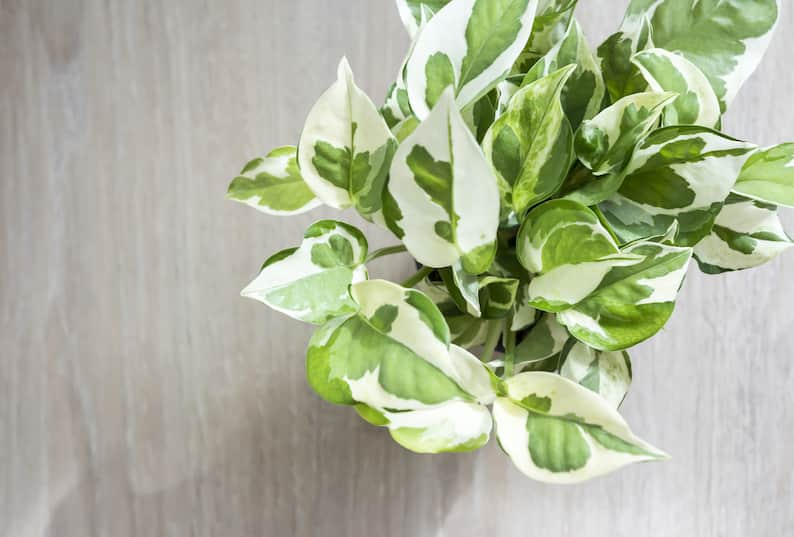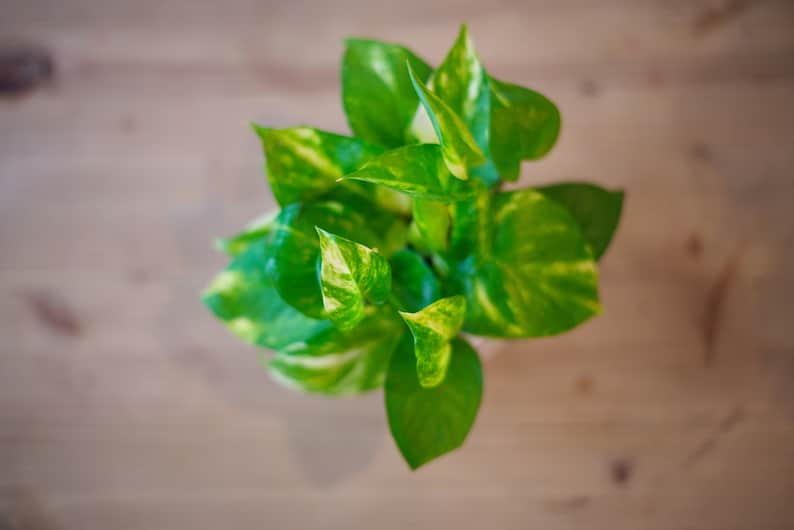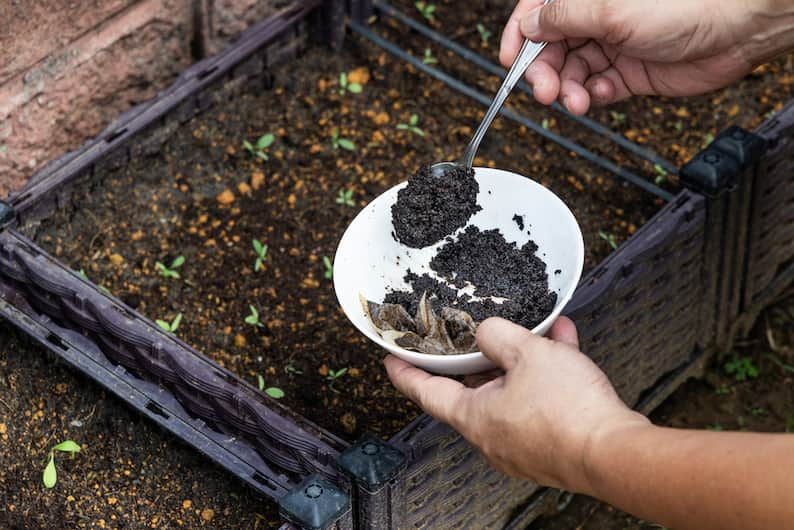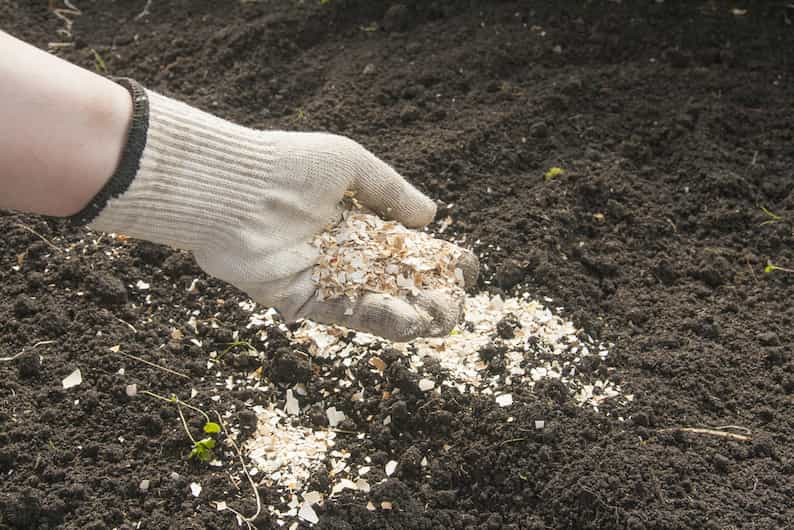Fertilizer is important for potted plants, especially when they are actively growing. But it can be a challenge to figure out what fertilizer to use and how often to apply it. In this post, we’ll share our top tips for fertilizing pothos plants.
The best fertilizer for pothos is a balanced, water-soluble fertilizer that contains nitrogen, phosphorus, and potassium. Apply the fertilizer according to the package directions. Be sure to dilute it slightly, as too much fertilizer can burn the roots of your plant. Many people add a small amount of fertilizer to their watering routine for consistent feeding.
Read on to learn more about the best fertilizer for pothos, including when to fertilize and how often to apply it. With a little practice and by paying a bit more attention to your plant, you will be a pro at fertilizing the pothos in no time!

Table of Contents
Can I use fertilizer on pothos?
Since the pothos plant is a fast-growing plant, it benefits from regular fertilization. Fertilize your pothos more often during the growing season and less during its dormancy in the colder months. This will give your pothos a fresh source of nutrients to help it thrive.
Houseplants such as the pothos need fertilizer because they don’t get the nutrients they need from natural sources like outdoor plants do. They can use up all of the available nutrients in the soil as quickly as 4 months after being potted. In addition to using fertilizer, you can repot your pothos every 12 to 18 months with fresh soil to ensure that it has fresh nutrients.
Best fertilizer for Pothos
Jack’s Classic 20-20-20 All Purpose Fertilizer
A great fertilizer with the perfect balance for your pothos. Simply dissolve in water and feed your plant to watch it thrive.
There are many household soils available that contain fertilizers. On the packaging, they will be listed as complete or balanced. These types of fertilizer have all the essential nutrients that your pothos needs for healthy growth.
Related: How Fast Does Pothos Grow (and How to Make it Grow Faster)?
What is the best fertilizer for pothos?
Your pothos will do well with an all-purpose fertilizer with a balanced nitrogen-phosphorus-potassium ratio (known as the NPK ratio). Specifically, look for a product that has an NPK ratio of 10-10-10, 15-15-15, or 20-20-20. This indicates that there is an even amount of each element in the fertilizer.
You can easily find this type of fertilizer at your local garden center or home improvement store. This even ratio is considered the best pothos fertilizer because it provides the nutrients they need in the right proportions.
If your pothos fertilizer’s NPK ratio is not balanced, you can still use it. However, you may need to adjust the amount of fertilizer you use. For example, if your fertilizer has a higher nitrogen ratio, you will need to use less of it.
Luckily, the pothos plant is flexible and resilient, so even if you make a mistake with the fertilizer, it will likely recover. Just be sure to read the instructions on your fertilizer’s packaging and follow them carefully.
My favorite pothos fertilizers are the following – whether you prefer a liquid or water soluble version.
1. Jack’s Classic All Purpose Fertilizer (20-20-20)

2. Triple 10 All Purpose Liquid Fertilizer (10-10-10)

When should I fertilize my pothos?
You should fertilize your pothos every two to four weeks during the growing season. This is typically from late spring to early fall. However, you don’t need to worry about fertilizing pothos in winter months, since the plant is dormant at that time.
That said, it’s important to remember that it’s better to use too little fertilizer than too much. Over-fertilizing can damage your pothos plant and even kill it.
When applying fertilizer, be sure to follow the package directions carefully. Over-fertilizing can damage your plant, so it’s important to apply the correct amount. Diluting your fertilizer will help protect your pothos from getting “burned” by a concentration of nutrients.
Make sure not to add too much water when fertilizing your plant. It likes to dry out between waterings, which helps to prevent root rot in your pothos.
How do I know when my pothos needs fertilizer?
A pothos plant needs fertilizer when it doesn’t have enough nutrients. Signs of this may include that your plant may be vulnerable to diseases and pests, show faded yellowing leaves, and have browned on the edge of the leaf. Its growth rate will also significantly drop.
If you haven’t been regularly feeding fertilizer to your pothos plant, these may be a few indicators that let you know it’s time to start. In addition, a droopy pothos can be a clear message that your plant needs some added nutrients.
Should you see any of these signs, begin fertilizing your pothos every two to four weeks. If the problem persists after a few months of fertilization, consider repotting your plant with fresh soil (here’s my pick for the best soil for pothos plants). This will give it a boost of nutrients and help it to recover.
Best soil for Pothos
Miracle-Gro Tropical Potting Mix
Light and well-draining (perfect for avoiding root rot) while being packed with just the right nutrients – that will feed your plant for up to six months. The best soil for keeping your pothos healthy and strong.
You don’t need to look out for these signs if you provide your plant with a small and consistent preventative dose of fertilizer throughout the growing season. This will help your pothos plant to maintain its health and prevent nutrient deficiencies.
How much fertilizer does a pothos need?
In general, you can mix 1 teaspoon of liquid fertilizer together with 2 cups of water for a proper dilution. This amount may vary depending on the type or strength of fertilizer you’re using, so make sure to pay close attention to the instructions on your fertilizer’s packaging.
As mentioned above, it’s important to give your pothos plant the right amount of fertilizer so that it can thrive without experiencing the all-too-common plant burn scenario.

Once you’ve mixed the fertilizer and water together, pour it over the soil around your pothos plant. Make sure to get the roots nice and wet so that they can absorb all of those nutrients! Pour the solution slowly so that it has a chance to seep down into the soil and reach the roots.
And there you have it! Now you know everything there is to know about fertilizing your pothos plant. Just remember to be careful with how much fertilizer you use, as too much can be just as harmful as too little.
Want to know more? Check out these tips to make your pothos fuller and bushier!
What is a natural fertilizer for pothos?
Sometimes store-bought fertilizer isn’t available or within the budget. Not to worry, there are plenty of great pothos DIY fertilizer ideas that will help to keep your pothos plant healthy. Here are some great natural fertilizer options:
- Compost: Compost is one of the best fertilizers for pothos plants. It’s rich in nutrients and helps to improve drainage for your pothos and aeration in the soil.
- Banana peels: Banana peels are a great source of potassium, which is essential for pothos plants. Just bury the peels a few inches in the soil around your plant and let nature do its thing!
- Aquarium water: If you have an aquarium, the water is a great natural fertilizer for pothos plants. Make sure to take the water out of the tank right before changing the water so that it has a high-nutrient density.
- Rice or potato cooking water: This is a great way to use up water that would otherwise go down the drain. It contains many helpful minerals for your pothos plant, such as calcium and potassium. Just let the water cool before pouring it over your pothos plant.
- Gelatin: Gelatin is a great source of nitrogen, which is essential for pothos plants. Just mix a packet of gelatin with some water and pour it over your plant.
- Green tea: This superfood contains phosphorus, magnesium, potassium, and calcium in it, making it a well-balanced fertilizer for pothos plants. Just brew a cup of tea and let it cool before pouring it over your plant.
As you can see, there are plenty of great natural fertilizer alternatives for pothos plants. Just remember to dilute them properly before applying them to your plant!
What is the best homemade fertilizer for pothos?
The best fertilizer for pothos plants is one that is well-balanced and contains all of the essential nutrients that pothos plants need to thrive. A great homemade fertilizer option is to mix together equal parts compost, green tea, and aquarium water. This mixture will provide your plant with a good balance of nitrogen, phosphorus, potassium, and calcium.
With so many options available when it comes to natural and homemade fertilizers, you may be wondering which one is best for your pothos plant. In brief, it doesn’t really matter, as all of the ones listed above can help your pothos to thrive.
One thing to keep in mind though is that it can be hard to get an accurate pothos fertilizer ratio when mixing your own homemade fertilizer, so make sure to do your research when it comes to the specific nutrients that your pothos plant needs. A little bit of trial and error may be necessary in order to find the perfect fertilizer ratio for your plant, but it will be well worth it in the end!
Do pothos in water need fertilizer?
Pothos plants that are growing in water still need to be fertilized on a regular basis in order to thrive. This is because the water doesn’t have the same reservoir of nutrients that the soil does and so the plant is constantly using up what little nutrients are available.
One miraculous thing about pothos plants is that they can actually grow in water. This is great for propagating pothos plants, but it doesn’t mean that they don’t need fertilizer.
Adding fertilizer to a pothos plant in water is easy. Simply follow the instructions and add the recommended amount of fertilizer to the water. Since the solution will be fully blended in the water and available to your plant, be extra careful not to over-fertilize.

What fertilizer to use for pothos in water?
The best fertilizer for pothos plants growing in water is an all-purpose indoor houseplant blend. Choose a liquid variety over a granular one so that it can be easily diluted and absorbed by your pothos evenly. Be mindful of the seasons. Just like pothos plants potted in soil, it’s important to allow dormancy and stop fertilizing in cold months.
The pothos plant functions a bit differently when grown in water than in soil, so you will want to use a fertilizer that is designed specifically for plants growing in water.
You can find all-purpose indoor houseplant fertilizer at your local gardening center or online. As mentioned earlier, my preferred one is the Triple 10 All Purpose Liquid Fertilizer (10-10-10).
Do pothos need nitrogen?
Nitrogen is an essential nutrient for your pothos plant. It is an important nutrient for photosynthesis, which helps your plant to create food. Nitrogen is also necessary for promoting the proper growth and development of leaves and stems.
For these reasons, it should be included in any fertilizer that you use for your pothos plant.
If you are unsure of whether or not your plant is getting enough nitrogen, look for signs of yellowing leaves or stunted growth in your pothos. These are both indicators that your plant is not getting enough nitrogen.
While nitrogen is important for pothos plants, too much nitrogen can actually be harmful. Be sure to follow the directions on your fertilizer carefully and only apply the recommended amount.
Are coffee grounds good for pothos?
Coffee grounds can be beneficial for pothos plants, but they should not be used as the sole source of fertilizer. This is because coffee grounds are high in nitrogen, which can actually burn the roots of your plant if it is applied in too high of a concentration.
These days, coffee grounds are a popular alternative to traditional fertilizers. But do they have the same effect on pothos plants?
Your leftover coffee grounds may be a good solution for your pothos plant if you’re trying to balance out a deficiency. If your plant is lacking in this nitrogen, carefully add a few grounds into the water or soil to see if it helps.
How to use coffee grounds for pothos
If you want to use coffee grounds as a fertilizer for your pothos plant, there are a few different ways that you can do it. One way is to add used coffee grounds directly to the soil around your plant. You can also brew a cup of coffee and water your plant with the leftover liquid.
(Just make sure it’s cooled off before adding it!)

Another way to use coffee grounds for pothos is to make a fertilizer tea. To do this, you’ll need to steep used coffee grounds in water for 24 hours. After the steeping process is complete, you can water your plant with the tea.
Try to test the acidity of your soil before adding coffee grounds to ensure that it won’t be too acidic for your pothos plant. You can do this by taking a small sample of soil and mixing it with water. Then, use a pH test kit to test the acidity of the soil.
The recommended pH level for pothos plants is between six and seven. If your soil is more acidic than that, hold back on adding the coffee grounds and look for a pH-balanced natural fertilizer.
Are eggshells good for pothos?
Eggshells can be beneficial for pothos plants, as they are high in calcium, which can actually build up in the soil and make it difficult for your plant to take up other important nutrients. They also help to improve drainage and aeration in the soil as well as leaf strength.
Since this is an easy and inexpensive way to add calcium to the soil, many gardeners choose to use eggshells as a fertilizer for their pothos plants.
Benefits of using eggshells for pothos
Calcium is an essential nutrient for pothos plants, and it helps with several things. It’s necessary for cell division, which helps the plant to grow. Calcium also helps the plant to take in other nutrients and strengthens the plant’s leaves.
Eggshells are made out of 90% calcium carbonate and 40% calcium, so it is a very rich source of these nutrients. When the eggshells decompose, they help to raise the pH level of the soil as well as improve drainage and aeration.
How to use eggshells for pothos
The best way to use eggshells for your pothos plant is to grind them up into a powder using a coffee grinder or food processor. Once they’re ground up, you can add them to the soil around your plant or mix them into your potting mix.
You can also make eggshell tea by steeping eggshells in water for 24 hours. After the steeping process is complete, you can water your plant with the tea.

If you’re repotting your pothos, you can simply add some eggshells to the bottom of your pot before adding the new soil. This will help improve drainage and aeration in the pot.
It’s important not to use too many eggshells, as they can make the soil too alkaline for your pothos plant. A good rule of thumb is to add about one eggshell per gallon of soil. You can also add them to your compost pile to dilute their effect.
Just like with coffee grounds, it’s important to test the soil before adding eggshells to make sure that they won’t make the soil too alkaline for your pothos plant. Also, make sure to fully clean off any egg that is leftover on the shells before using them with your plant.
Is Epsom salt good for pothos?
Epsom salt is particularly helpful for pothos plants because it contains sulfur and magnesium, which help to improve the plant’s growth and to reduce brown spots. It also helps to prevent yellowing of the leaves and can promote root growth.
Epsom salt is a type of magnesium sulfate that can be beneficial for plants. It can help to improve the absorption of other nutrients, as well as strengthen the plant’s cell walls.
An added benefit is that Epsom salt is very affordable and can be found almost anywhere, making this an accessible fertilizer for all houseplant owners.
Benefits of using Epsom salt for pothos
Epsom salt is a good source of magnesium, which is an essential nutrient for plants. Magnesium helps with several things, including the absorption of other nutrients, cell division, and the strengthening of cell walls.
Sulfur is another important nutrient that is found in Epsom salt. Sulfur helps to improve the plant’s growth, as well as reduce brown spots on your pothos. It also helps to prevent yellowing of the leaves and can promote healthy root growth.
How to use Epsom salt for pothos
Epsom salt can be added to the soil around your pothos plant or mixed into your potting mix. You can also make a solution by dissolving Epsom salt in water and then watering your plant with it.
You can also spray your pothos plant with a solution of Epsom salt and water to help prevent brown spots on the leaves. This allows for a more targeted application and can be especially helpful if your plant is already showing signs of brown spots.
Is Osmocote good for pothos?
Osmocote is a great choice for your pothos plant and makes the fertilizing process easier since you can apply it once during the growing season and it will last for several months. It is a blend of nitrogen, phosphorus, and potassium that helps to promote healthy growth in plants.
If you haven’t heard of it before, Osmocote is a type of slow-release fertilizer that can be beneficial for plants. It’s made up of small pellets that contain nutrients that are released over time, making it a good option for plants that need a consistent supply of nutrients.
The biggest drawback of using a slow-release fertilizer such as this is that it is hard to measure the number of nutrients that your plant is receiving. Err on the side of caution and use less rather than more, as too much fertilizer can burn your plant’s roots.


